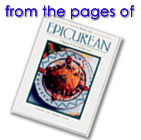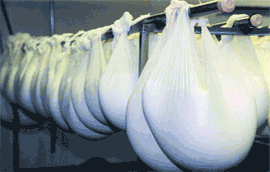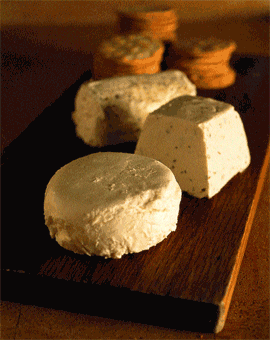
 |
|||||
|
|
|
|
|
|
|
For the Love of Cheeseby Gale Gand |
|

Cheese is one of man's oldest forms of nourishment with stories of it being at least 3000 years old. Cheese making, technically speaking, is the practice of harnessing bacteria and incorporating it into milk or curds for the benefit of different flavors and textures. To give the cheese even more depth and flavor, affinage, the French word for "the aging process," is the finishing school for these nuggets of milk, elevating the craft of cheese making to an art form. Aging is done in cool rooms with air circulating around the young cheese encouraging it to intensify its flavor and sometimes ripen to a creamy texture. In effect, the cheese maker nurtures a living, breathing food to feed the stomach and the soul. Most countries have cheeses native to them: the Italians have their famous Parmigiano-Reggiano; the Spanish have Manchego; the British have farmhouse Cheddar, and the Americans have Monterey Jack. But the French are the mothers of cheese making with a claim to 675 varieties, almost two for every day of the year! There are many factors that influence the flavor of the cheese. The shape, the quality and fat content of the milk, and even what the animals were fed. The milk is either cow, sheep, goat or even yak's milk in China. Milk can be raw or pasteurized, but if it is raw and from a foreign country it must be aged over 60 days before it can be brought into the US. Rennet, which is an enzyme used to coagulate the milk, is added to the milk after it has been heated to various temperatures. This coagulation process allows the protein or curds to group up and separate from the liquid whey. Salt is added for flavor and to encourage moisture release once the curds have been ladled into molds and begin to age. There are three types or levels of cheese production: "fermier" or farmstead where the milk comes from herds on that cheese maker's farm only and is hand produced; "artisanal" where the milk come from the same controlled area and is hand produced; and "industrial" where the milk can come from anywhere and is produced with the aid of heavy machinery for various steps of the process, including depositing the curds into their molds. Then there are three types of rinds. "Flourished" rind, with or without ash, looks a bit like a fluffy white coat all over the cheese. Then there's "washed" rinds where the surface is brushed with some type of liquid, commonly brandy, wine or eau de vie to impart flavor. And then there's a "natural" rind, with or without ash, which is wrapped in cheese cloth and air-dried. Ash may be applied to the surface of a cheese to help pull moisture out, or sometimes the fresh curds are simply wrapped in chestnut leaves to impart some flavor without much age and develop no rind at all because of their youth. Most rinds are edible with the exception of the harder firmer natural rinds. But some people find the intensity or pungent quality of some rinds not to their liking and choose to leave it on the edge of their plates.

Roquefort is a good example of one of the oldest cheeses on record. It's a raw sheep's milk cheese from Larzac, Averyron in the Aquitaine region of France. It has been called the King of Cheese and the Cheese of Kings. The milk has 52% butterfat and the curds are cut by hand, not a machine, to help them release their whey, then are packed into molds with a layer of powdered penicillium Roquefort shaken over the surface, and then more curds packed on top of that. Industrially produced Roquefort cheese has the penicillium injected into the curds as a liquid through needles. But all versions of Roquefort cheese come from sheep's milk collected from that particular region. It is aged 60 to 90 days, being turned several times per day to keep the moisture evenly distributed. The rounds are aged in the famous caves of Roquefort, which are catacombs inside limestone hills. The air current is cool and humid, creating a perfect environment for the cheese to "affinage" or age, and the air naturally contains the penicillium. A charter to control and protect its quality was signed in 1411 by King Charles the VI of France, but the legend of its origin is that 2000 years ago, on a hot summer's day, a shepherd had his daily lunch in a leather sack, some rye bread topped with fresh sheep cheese, and stuck it in a nearby cave to keep it cool until lunch. The sheep were threatened by wolves, so the shepherd quickly took his sheep from the area, leaving his lunch behind. Reluctant to return the next day, he grazed his flocks on other hills. Three months later he returned with his sheep to that same hillside and found his sandwich. The cheese had developed a blue mold from the penicillium-laden air it was exposed to in the cave. He found the taste was wonderfully nutty and slightly sharp, and the rest is history... The Fun - A Closer Look at Goat Cheese Am I the only one that thinks of California the second I hear goat cheese is being served? And why is that? Perhaps it's because of the strong influence Alice Waters had on our collective culinary consciousness when she was |

sought out by Laura Chenel, a boutique goat cheese maker in Sonoma in 1979, who created her goat cheese for Waters' famous Berkeley restaurant, Chez Panisse. I think that's how the whole goat cheese brushfire got started. And when we were invited as part of a group to stay at a big beautiful house in Montana for Thanksgiving in 1995, my Pavlovian response was solidified. Five couples were invited to spend the holidays together in a timber house in Whitefish, Montana, and as the only chefs in the bunch I put out a 911 call to the host, concerned my husband and I would be cooking three squares for a family of 10 for five days. I was assured that each couple would be cooking one night. So I picked my favorite meal to cook - Thanksgiving, of course. The couple who had been college buddies made Lasagna; the host, a food importer, made a glorious bone-in ham; the city couple with no kids made reservations; and Laura Chenel made artichoke and goat cheese pizzas. That supported my generalizations about people from California and food and goat cheese. And by the way, those pizzas were outstanding. Really, so delicious I almost cried. Over that week, I got pregnant with the soon to be Giorgio Montana. Since then we've all welcomed this semi newcomer [the cheese, not Giorgio] into our family and our refrigerators, ordering it in restaurants crumbled, warmed, stuffed in pasta or chicken, or even atop a pizza. But to truly understand the beast, I decided to jump on an airplane with my son Gio (Giorgio now three) and spend a week with Judy Schadd at Capriole Farms in Greenville, Indiana, 30 minutes outside of Louisville, Kentucky. Her place is the quintessential farmstead experience, creating some of the most delicious and finest goat cheeses in this country. Not only does she keep 175 goats (of which 1/3 are giving milk twice a day), but she also grows her own straw to feed the goats. This total immersion in the making of the cheese from start to finish, from straw to the table, is a devotion not often seen. Judy's hospitable personality helped me to understand where the extra special nature of her cheese comes from - it involves family, friends, and employees whose caring touch helps nurture the curds along to greatness. It felt like an entire village, with Judy as the well-loved mayor working around the clock to keep everyone happy, healthy, fed, watered, dry and trimmed. Running a farm presents some fascinating challenges, from Judy and her husband helping pregnant mother goats give birth in the middle of the night, to tearing across the farm at the bleating cry for help from a young goat whose horns are stuck in a fence. We watched the gathering of the smooth silky milk, and the slow warming of this liquid gold to form curds. Looking like newborns in bundles brought by the stork, the curds are wrapped in cheese cloth and hung to drain and shed their whey. Then the curds are hand formed into what will become Judy's Wabash Cannon Ball dipped in ash, or her elegant conical shaped Crocodile Tears rolled in paprika, before allowing a soft flourished white rind to develop. We even were treated to a swig of the tart clear whey from a drain spout, high in nutrition and character. After a week of fresh crisp air, breakfasts of smoky bacon with farm fresh eggs (better than smoky air and crisp bacon!), dangerous adventures down the hill to the rushing creek, afternoon checking on our new baby goat friends, and late dinners with red wine, we didn't want to leave. Each night Gio and I had to check the moon to see its shape and say good night to his two favorite goats which he named Chocolate, a brown one, and a white one named Blanco. Then we were ready, more than ready, to put ourselves to bed.
Returning to Chicago after our retreat, I found I wanted to reminisce about the world we had left behind. This experience inspired me to come back to my Chicago restaurants, Brasserie T and Tru, and start celebrating the virtues of goat cheese. A warm goat cheese and tomato appetizer came out of the Brasserie's kitchen and a goat cheese cake with poached rhubarb and strawberry consommè began to appear on the dessert menu at Tru. I also serve an extensive cheese cart at one of my restaurants with 18 to 24 varieties of cheeses each day. My love affair with cheese continues to flourish, like that of a young velvety white rind in a moist environment, and my appetite is only satiated by the act of teaching and sharing these precious morsels with others.
|
| |||||